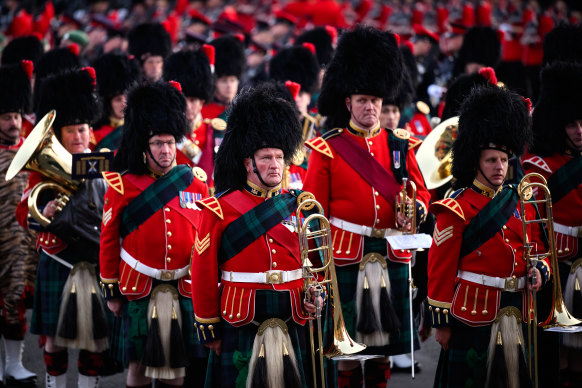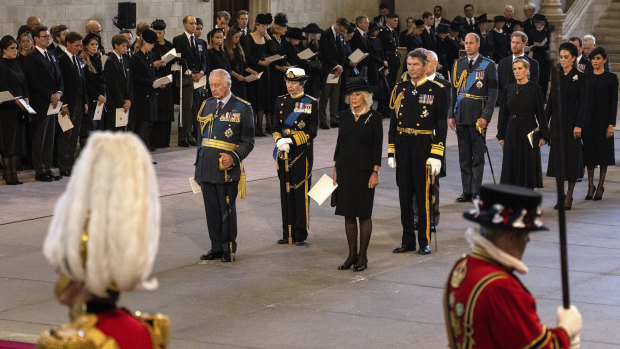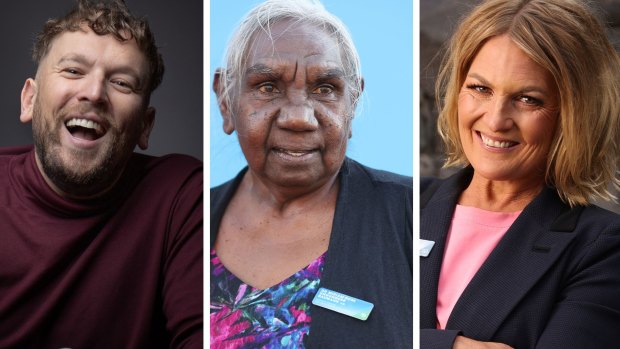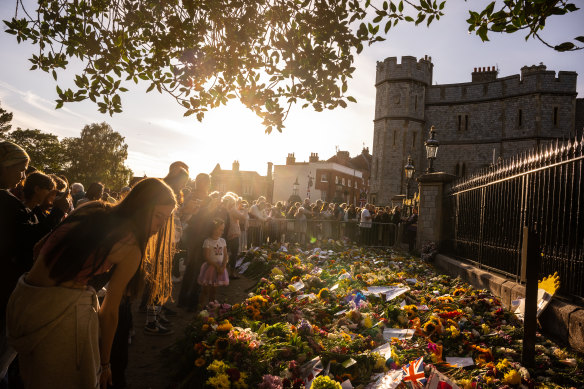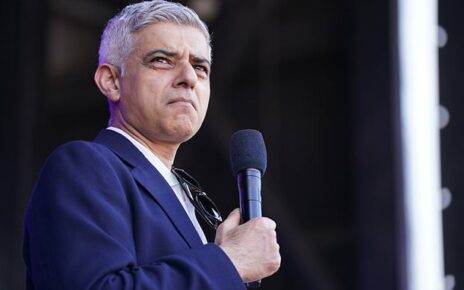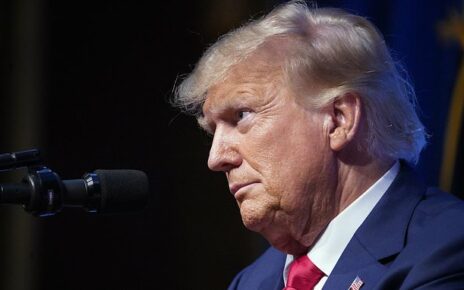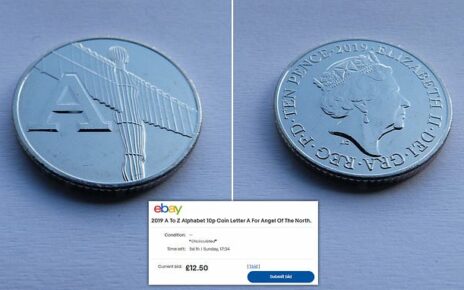London: The world will pay its final respects to Queen Elizabeth II on Monday, with nearly 500 dignitaries from around the world attending her state funeral at Westminster Abbey and as many as 2 million people expected to line the streets of London.
From the doors of Westminster Hall closing to the public, who’ve queued up to see the Queen lying-in-state over a number of days, to the burial at Windsor Castle, here is everything you need to know about the details of the late monarch’s funeral proceedings.
Queen Elizabeth II’s funeral will take place in Westminster followed by the Committal Service and burial in Windsor.Credit:Getty Images Europe
The procession to Westminster Abbey
The final members of the public will be admitted to Westminster Hall to view the Queen’s lying-in-state at 6.30am (3.30pm AEST), after which preparations for the state funeral will take precedence.
At 10.35am (7.35pm AEST), a bearer party founded by The Queen’s Company, 1st Bn Grenadier Guards, will lift the coffin from the catafalque and place it on the state gun carriage of the Royal Navy, which was retired from service in 1901 for the funeral of Queen Victoria. It will be drawn by hand by 142 Royal Navy ratings through Parliament Square, where a tri-service Guard of Honour will be standing to attention.
Led by the massed pipes and drums of the Scottish and Irish regiments, the Brigade of Gurkhas and the RAF, the coffin, which will be followed on foot by the King and members of the royal family, will arrive at the West Gate of Westminster Abbey at 10.52am, where the bearer party will carry it into the Abbey and place it on a catafalque.
Where is the funeral, and what time does it start?
Beginning at 11am (8pm AEST) Monday at Westminster Abbey, the state funeral is expected to be one of the most-watched televised events in history, with potential global figures reaching the billions.
It will be conducted by the Dean of Westminster, with lessons read by UK Prime Minister Liz Truss and the Commonwealth secretary-general, and a sermon delivered by the Archbishop of Canterbury.
The 2000-strong congregation, who will start arriving from 8am (5pm AEST), will include Royal family members, heads of state and members of the Government, but also emergency workers, George Cross and Victoria Cross recipients and members of the public who were recognised for their public service in the most recent Queen’s birthday honours.
How you can watch the Queen’s funeral
- You can follow The Sydney Morning Herald and The Age’s coverage online via the live blog, including a livestream of the funeral proceedings.
- Nine News will run a broadcast during the day, which recommences at 7pm (AEST) following the 6pm news bulletin.
- Seven will run a broadcast during the day that only pauses for its 6pm news bulletin. Elsewhere, the ABC will do the same, pausing for 20 minutes at 7pm for news, while SBS will begin broadcasting from 7.30pm. Ten’s broadcast commences at 8pm on Ten Bold.
Visiting heads of state and overseas government representatives will muster at the Royal Hospital Chelsea to be taken in buses to the Abbey, though so-called “top tier” heads of state, including US President Joe Biden, will be allowed to use their own transport.
At 11.55am (8.55pm AEST), the Last Post will sound, followed by a two minutes’ silence both in the Abbey and throughout the UK. The service will end at noon with the National Anthem and a lament played by the Queen’s piper, Pipe Major Paul Burns of the Royal Regiment of Scotland. The bearer party will then carry the coffin back to the waiting gun carriage for the next stage of the late Queen’s journey.
When the service ends, visiting heads of state will walk to Church House next to the Abbey for a reception hosted by James Cleverly, the Foreign Secretary.
King Charles III, Princess Anne, Camilla, the Queen Consort, Tim Laurence, Prince Edward, and Prince William.Credit:AP
Which royals will attend, and why won’t everyone be dressed in military uniform?
The late Queen’s four children – King Charles III, Princess Anne, Prince Andrew and Prince Edward – will all be present at the funeral, as well as their respective spouses: Camilla, the Queen Consort; Sophie, Countess of Wessex and Sir Tim Laurence. The Duke of York’s ex-wife Sarah Ferguson is also expected to attend.
The late Queen’s grandchildren will also be in attendance at the service – Prince William, Prince Harry, Peter Phillips, Zara Tindall, Princess Beatrice, Princess Eugenie, Lady Louise Windsor and James, Viscount Severn.
Spouses of close family, including Catherine, the Princess of Wales and Meghan, the Duchess of Sussex will also be present to pay their respects.
Other royals expected to attend include the late Queen’s cousins: Duke of Kent, Prince and Princess Michael of Kent, Princess Alexandra and Prince Richard, Duke of Gloucester.
Working members of the Royal Family are expected to wear military uniforms. Prince Andrew, Duke of York and Prince Harry, Duke of Sussex will be in morning dress, with medals, as they are no longer working members of the family.
Which world leaders will attend?
Commonwealth leaders such as Australian Prime Minister Anthony Albanese, New Zealand Prime Minister Jacinda Ardern and Canadian Prime Minister Justin Trudeau will be in the UK to pay their respects.
US President Joe Biden will attend with First Lady Jill Biden. Former presidents Barack Obama and Donald Trump will not attend, the White House confirmed.
From the G7, French President Emmanuel Macron, European Commission President Ursula von der Leyen, German President Frank-Walter Steinmeier and Italian President Sergio Mattarella will also be present.
Elsewhere, from around the globe: Brazilian President Jair Bolsonaro, Turkish President Recep Tayyip Erdoğan, South Korean President Yoon Suk-Yeol.
Indian Prime Minister Narendra Modi is yet to confirm whether he will be there, and it is unknown whether Chinese President Xi Jinping received an invitation. Russian President Vladimir Putin did not.
What about other Australians?
Albanese, Governor-General David Hurley and the acting high commissioner to the United Kingdom, Lynette Wood, will lead Australia’s delegation.
Paralympic champion and tennis golden slam winner Dylan Alcott and seven Australian of the Year nominees – 2022 Senior Australian of the Year Val Dempsey, 2021 Senior Australian of the year Dr Miriam-Rose Ungunmerr Baumann, 2022 Australian of the Year Local Hero Shanna Whan, Queensland’s local hero nominee, Saba Abraham, and Tasmanian counterpart Kim Smith, South Australia’s Young Australian of the Year, Trudy Lin, and Western Australia’s 2021 Australian of the Year Professor Helen Milroy – will also be in attendance.
Paralympic champion and tennis golden slam winner Dylan Alcott, 2021 Senior Australian of the year Dr Miriam-Rose Ungunmerr Baumann, 2022 Australian of the Year Local Hero Shanna Whan. Credit:Simon Schluter/ Alex Ellinghausen/Alex Ellinghausen
Controversial former soldier Ben Roberts-Smith will participate in the official commemorations. A select group of Australian war veterans was invited to the funeral commemorations by the Victoria Cross and George Cross Association on behalf of the Queen.
Gai and Robert Waterhouse will also attend.
The rules for attending the funeral
Queen Elizabeth II’s funeral will reflect the changing times, with women advised that “trouser suits may be worn”.
Serving members of the Armed Forces are told to wear full ceremonial dress and mourning bands, but are warned “no swords”.
Men can wear morning dress or lounge suits, while women can wear day dress, including hats. Decorations are allowed.
On the reverse of the admission card is a guest checklist containing “critical information” that they are advised to read carefully.
The scale of the security operation surrounding the event means that mourners will be required to show two forms of identification, including a photograph and proof of address.
They are told not to take cameras or any hand luggage, bar handbags and rainwear.
They must arrive at the accreditation area for security checks and Metropolitan Police searches from 8am.
The invitation warns that attendees will face passing through “airport-style search arches” as a condition of entry into Westminster Abbey and they are urged to assist the police in the “smooth running” of the checks.
– The Telegraph
What role will Commonwealth nations play in proceedings?
“Mounties” of the Royal Canadian Mounted Police will have the honour of leading the coffin procession through London as it is taken from Westminster Abbey to Wellington Arch to begin its journey to Windsor.
The late monarch was given her favourite horse, Burmese, by the Royal Canadian Mounted Police in 1969 and rode the mare at Trooping the Colour for 18 consecutive years.
Among those following behind will be detachments from the Armed Forces of the Commonwealth, thought to include troops from New Zealand, Canada and Australia.
Baroness Scotland, the secretary general of the Commonwealth, was chosen to read lessons in the service, alongside Liz Truss, the Prime Minister.
What happens directly after the funeral?
For the last time, the late Queen’s coffin will pass the London landmarks that dictated her life’s routine through annual rituals that she performed 70 times. At 12.15pm (9.15pm AEST), the coffin procession will set off for Wellington Arch at Hyde Park Corner, taking it through Whitehall, The Mall, past the front of Buckingham Palace and up Constitution Hill.
The route will be lined by members of the Armed Forces and members of the public will be able to watch.
Mounties of the Royal Canadian Mounted Police will lead the procession, followed by George Cross recipients, NHS workers, officers of the Police Service of Northern Ireland and detachments of the Armed Forces. There will be seven groups in total, each supported by a service band.
The coffin will be flanked by the sovereign’s ceremonial bodyguards, including Yeomen of the Guard and the Royal Company of Archers, and the King and other members of the Royal family will walk behind it.
Minute guns will be fired by the King’s Troop and Royal Horse Artillery, and Big Ben will toll throughout the procession.
At the Cenotaph, where the late Queen attended Remembrance Sunday services every year, ex-service association standard bearers will stand to attention; at Horse Guards, the location of the annual Trooping the Colour ceremony, the King’s Life Guard will give a royal salute to the coffin. And on the forecourt of Buckingham Palace, the King’s Guard will give another royal salute as the coffin passes the Queen Victoria Memorial.
The procession will arrive at Wellington Arch at 1pm (10pm AEST), where the coffin will be placed in a state hearse for the journey to Windsor.
How the Queen’s final journey will unfold
The hearse is expected to take almost two hours to make the 20-mile (32km) journey from Wellington Arch to Windsor Castle. Precise details of the route have not yet been published, but the hearse is expected to be driven through London suburbs and Berkshire villages so that as many members of the public as possible can see it go past, while the Royal family go on ahead via the faster M4.
At 3.06pm (12.06am Tuesday AEST), the hearse will approach Shaw Farm Gate on Albert Road, Windsor and join a procession that will have been formed up and in position by then.
At 3.10pm (12.10am AEST), the procession will step off, travelling up the Long Walk to Windsor Castle and entering via the George IV Gate. Minute guns will be fired from the east lawn and both the Sebastopol Bell – brought back from the Crimean War and only struck when a monarch dies – and the Curfew Tower Bell, which rings on major royal occasions, will toll.
The King and other members of the Royal family will be waiting in the quadrangle of the Castle, where they will fall in behind the coffin at 3.40pm (12.40am AEST) and walk the short distance through the Castle precincts to St George’s Chapel.
The hearse will stop at the bottom of the West Steps of St George’s Chapel at 3.53pm (12.53am AEST) and the coffin will be carried inside and placed on a catafalque in the quire, in the same spot that Prince Philip’s coffin was placed during his funeral last year.
How will the Committal Service work?
Members of the Royal family will be joined by members of Her Majesty’s household past and present, including personal staff who work, or have worked, on the Sandringham and Balmoral estates. They are expected to include footmen, cooks, gamekeepers and gardeners as well as administrative staff.
Governors general and prime ministers of the Commonwealth realms, including Anthony Albanese) will arrive at 3.20pm (12.20am AEST), with members of the Royal family who are not walking behind the coffin arriving at 3.25pm (12.25am AEST).
The service will begin at 4pm (1am AEST), conducted by the Dean of Windsor, with prayers said by the Rector of Sandringham, the Minister of Crathie Kirk and the Chaplain of Windsor Great Park.
In what is likely to be one of the most moving moments of the day, Queen Elizabeth II will finally part company with the Imperial State Crown, orb and sceptre near the end of the committal.
Throughout her lying in state, the symbols of monarchy have adorned her coffin, and they will only be removed in the final moments before the public sees its last images of the monarch’s coffin.
Before the final hymn is sung, Mark Appleby, the Crown Jeweller, will remove the crown, orb and sceptre from the coffin, with the help of the Bargemaster and the Serjeants-at-Arms (royal servants who guard the regalia during State occasions), and pass them one by one to the Dean of Windsor, who will place them on the High Altar.
While the crown represents the sovereign’s power over her subjects, the orb, made up of a cross above a globe, represents Christ’s earthly dominion and symbolises the monarch’s status as God’s mortal representative. The sceptre, which holds the world’s largest cut diamond, the Cullinan I, represents equity and mercy. They will be presented to the King at his Coronation next year.
At the end of the hymn, the King will place a military flag on top of the coffin, which, according to the Army, will be placed inside the coffin before it is interred.
The Grenadier Guards Queen’s Company Camp Colour – a small flag that normally adorns the Company Captain’s bunk designating his place of work – is unique to each sovereign and ceases to be used when they die. The full-sized version of the flag is currently draped at the foot of the Queen’s coffin as she lies in state. The Grenadier Guards are the most senior of the Foot Guards regiments, and the Queen was their Colonel in Chief.
Once the King has placed the colours on top of the coffin, the Lord Chamberlain, the most senior officer of the Royal household, will break his wand of office and place it on the coffin.
As the coffin is lowered into the royal vault – as Prince Philip’s coffin was on the day of his funeral last year – the Dean of Windsor will say a psalm and the commendation before the Garter King of Arms reads out the styles and titles of the Queen.
The burial
Queen Elizabeth II will be lowered into her final resting place alongside her husband, parents and sister in a “deeply personal” private ceremony attended only by her closest family members.
The late Queen will be interred in a tiny family vault, which she commissioned in 1962 as a burial place for her father, King George VI. It was designed, in accordance with her wishes, to accommodate her mother, Queen Elizabeth, her husband, Prince Philip, and herself.
The interment will not be televised or photographed, and the chapel is so small that only the late Queen’s four children are expected to be inside it for the interment itself, together with the Dean of Windsor and the pallbearers who will lower the two lead-lined coffins into the vault.
People gather at the gates of Windsor Castle to lay flowers. Queen Elizabeth II will be buried in the King George VI Memorial Chapel, within St George’s chapel in the grounds of Windsor Castle.Credit:Getty Images Europe
A senior palace official said: “The burial will be entirely private, given it is a deeply personal family occasion.”
Having been temporarily lowered into the royal vault during the committal in St George’s Chapel, the late Queen’s coffin and that of Prince Philip will be put on an electric lift, hoisted back into the chapel and carried to the King George VI Memorial Chapel ready for the interment ceremony at 7.30pm.
The black Belgian marble stone that covers the vault will be lifted and the coffins will be interred alongside the Queen’s parents and her sister, Princess Margaret, whose ashes were placed in a nook to one side when the vault was opened in 2002 for the interment of Queen Elizabeth, the Queen Mother.
The stone will be replaced, and the names of Elizabeth II and Philip added to it, where the public will, eventually, be able to see the final resting place of our most dutiful monarch.
The Telegraph, London
The Morning Edition newsletter is our guide to the day’s most important and interesting stories, analysis and insights. Sign up here.
Most Viewed in World
From our partners
Source: Read Full Article
